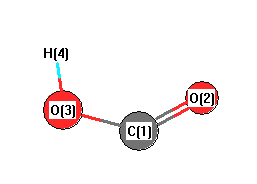Jump to
S1C2
Energy calculated at QCISD/aug-cc-pVTZ
| | hartrees |
|---|
| Energy at 0K | -188.824053 |
| Energy at 298.15K | -188.825142 |
| HF Energy | -188.208336 |
| Nuclear repulsion energy | 63.189094 |
The energy at 298.15K was derived from the energy at 0K
and an integrated heat capacity that used the calculated vibrational frequencies.
Vibrational Frequencies calculated at QCISD/aug-cc-pVTZ
| Mode Number |
Symmetry |
Frequency
(cm-1) |
Scaled Frequency
(cm-1) |
IR Intensities
(km mol-1) |
Raman Act
(Å4/u) |
Dep P |
Dep U |
|---|
| 1 |
A' |
3692 |
3554 |
37.11 |
|
|
|
| 2 |
A' |
1867 |
1797 |
318.51 |
|
|
|
| 3 |
A' |
1323 |
1273 |
0.20 |
|
|
|
| 4 |
A' |
1094 |
1053 |
191.12 |
|
|
|
| 5 |
A' |
608 |
585 |
33.52 |
|
|
|
| 6 |
A" |
572 |
551 |
109.56 |
|
|
|
Unscaled Zero Point Vibrational Energy (zpe) 4578.1 cm
-1
Scaled (by 0.9624) Zero Point Vibrational Energy (zpe) 4405.9 cm
-1
See section
III.C.1 List or set vibrational scaling factors
to change the scale factors used here.
See section
III.C.2
Calculate a vibrational scaling factor for a given set of molecules
to determine the least squares best scaling factor.
Geometric Data calculated at QCISD/aug-cc-pVTZ
Point Group is Cs
Cartesians (Å)
| Atom |
x (Å) |
y (Å) |
z (Å) |
|---|
| C1 |
0.000 |
0.443 |
0.000 |
| O2 |
-1.062 |
-0.358 |
0.000 |
| O3 |
1.156 |
0.185 |
0.000 |
| H4 |
-0.749 |
-1.277 |
0.000 |
Atom - Atom Distances (Å)
| |
C1 |
O2 |
O3 |
H4 |
| C1 | | 1.3302 | 1.1842 | 1.8767 |
O2 | 1.3302 | | 2.2832 | 0.9715 | O3 | 1.1842 | 2.2832 | | 2.4015 | H4 | 1.8767 | 0.9715 | 2.4015 | |
 More geometry information
More geometry information
Calculated Bond Angles
| atom1 |
atom2 |
atom3 |
angle |
|
atom1 |
atom2 |
atom3 |
angle |
| C1 |
O2 |
H4 |
108.228 |
|
O2 |
C1 |
O3 |
130.386 |
Electronic energy levels
Charges, Dipole, Quadrupole and Polarizability
Jump to
S1C1
Energy calculated at QCISD/aug-cc-pVTZ
| | hartrees |
|---|
| Energy at 0K | -188.826793 |
| Energy at 298.15K | -188.827860 |
| HF Energy | -188.209240 |
| Nuclear repulsion energy | 62.961697 |
The energy at 298.15K was derived from the energy at 0K
and an integrated heat capacity that used the calculated vibrational frequencies.
Vibrational Frequencies calculated at QCISD/aug-cc-pVTZ
| Mode Number |
Symmetry |
Frequency
(cm-1) |
Scaled Frequency
(cm-1) |
IR Intensities
(km mol-1) |
Raman Act
(Å4/u) |
Dep P |
Dep U |
|---|
| 1 |
A' |
3849 |
3704 |
124.77 |
|
|
|
| 2 |
A' |
1911 |
1839 |
238.14 |
|
|
|
| 3 |
A' |
1270 |
1223 |
246.54 |
|
|
|
| 4 |
A' |
1096 |
1055 |
73.41 |
|
|
|
| 5 |
A' |
624 |
600 |
5.24 |
|
|
|
| 6 |
A" |
530 |
510 |
84.24 |
|
|
|
Unscaled Zero Point Vibrational Energy (zpe) 4639.9 cm
-1
Scaled (by 0.9624) Zero Point Vibrational Energy (zpe) 4465.5 cm
-1
See section
III.C.1 List or set vibrational scaling factors
to change the scale factors used here.
See section
III.C.2
Calculate a vibrational scaling factor for a given set of molecules
to determine the least squares best scaling factor.
Geometric Data calculated at QCISD/aug-cc-pVTZ
Point Group is Cs
Cartesians (Å)
| Atom |
x (Å) |
y (Å) |
z (Å) |
|---|
| C1 |
0.000 |
0.408 |
0.000 |
| O2 |
-0.943 |
-0.548 |
0.000 |
| O3 |
1.169 |
0.256 |
0.000 |
| H4 |
-1.803 |
-0.115 |
0.000 |
Atom - Atom Distances (Å)
| |
C1 |
O2 |
O3 |
H4 |
| C1 | | 1.3426 | 1.1785 | 1.8775 |
O2 | 1.3426 | | 2.2596 | 0.9627 | O3 | 1.1785 | 2.2596 | | 2.9950 | H4 | 1.8775 | 0.9627 | 2.9950 | |
 More geometry information
More geometry information
Calculated Bond Angles
| atom1 |
atom2 |
atom3 |
angle |
|
atom1 |
atom2 |
atom3 |
angle |
| C1 |
O2 |
H4 |
107.925 |
|
O2 |
C1 |
O3 |
127.222 |
Electronic energy levels
Charges, Dipole, Quadrupole and Polarizability
